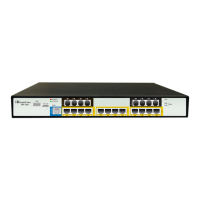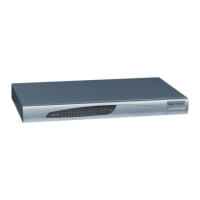SIP User's Manual 58 Document #: LTRT-12801
MP-500 MSBG
3.4 Configuration Tab
The Configuration tab on the Navigation bar displays menus in the Navigation tree related
to device configuration. These menus include the following:
Network Settings (refer to ''Network Settings'' on page 58)
Media Settings (refer to ''
Media Settings'' on page 65)
Securit
y Settings (refer to ''Security Settings'' on page 132)
Protocol Co
nfiguration (refer to ''Protocol Configuration'' on page 141)
Adv
anced Applications (refer to ''Advanced Applications'' on page 224)
3.4.1 Network Settings
The Network Settings menu allows you to configure various networking parameters. This
menu includes the following items:
IP Settings (refer to ''Configuring the Multiple Interface Table'' on page 58)
Applicatio
n Settings (refer to ''Configuring the Application Settings'' on page 62)
IP Routing Ta
ble (refer to ''Configuring the IP Routing Table'' on page 63)
QoS Settings (refe
r to ''Configuring the QoS Settings'' on page 64)
3.4.1.1 Configuring the Multiple Interface Table
The 'Multiple Interface Table' page allows you to configure up to 16 logical network
interfaces, each with its own IP address, unique VLAN ID (if enabled), interface name, and
application type permitted on the interface:
Control
Media
Operations, Administration, Maintenance and Provisioning (OAMP)
When operating with both voice and data routing functionalities, the 'Multiple Interface
Table' page allows you two configure the following two mandatory LAN IP addresses:
Voice (VoIP) and management functionality ("OAMP + Media + Control")
Data router functionality with security ("Data")
The default IP addresses (in subnet mask 255.255.255.0) of these LAN interfaces are listed
below:
Voice (VoIP) and Management: 192.168.0.2 (default gateway is 192.168.0.1, i.e., the
interface of the data)
Data: 192.168.0.1 (default gateway is 0.0.0.0)
However, if you wish to operate the device with only voice functionality, you can configure
a different default gateway (instead of the data router functionality). For disabling the data
routing functionality, refer to “Disabling Data Routing Functionality” on page 25.

